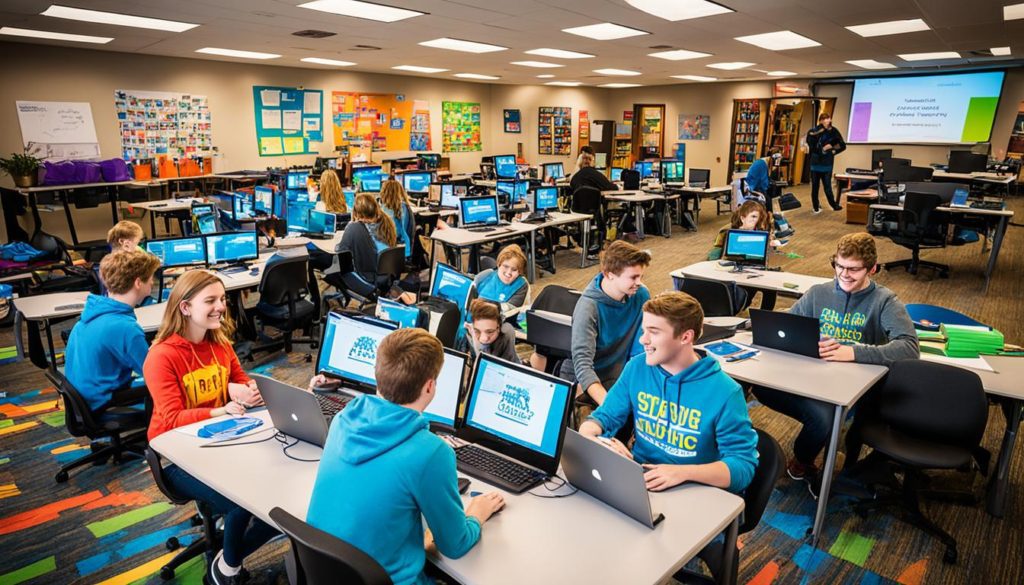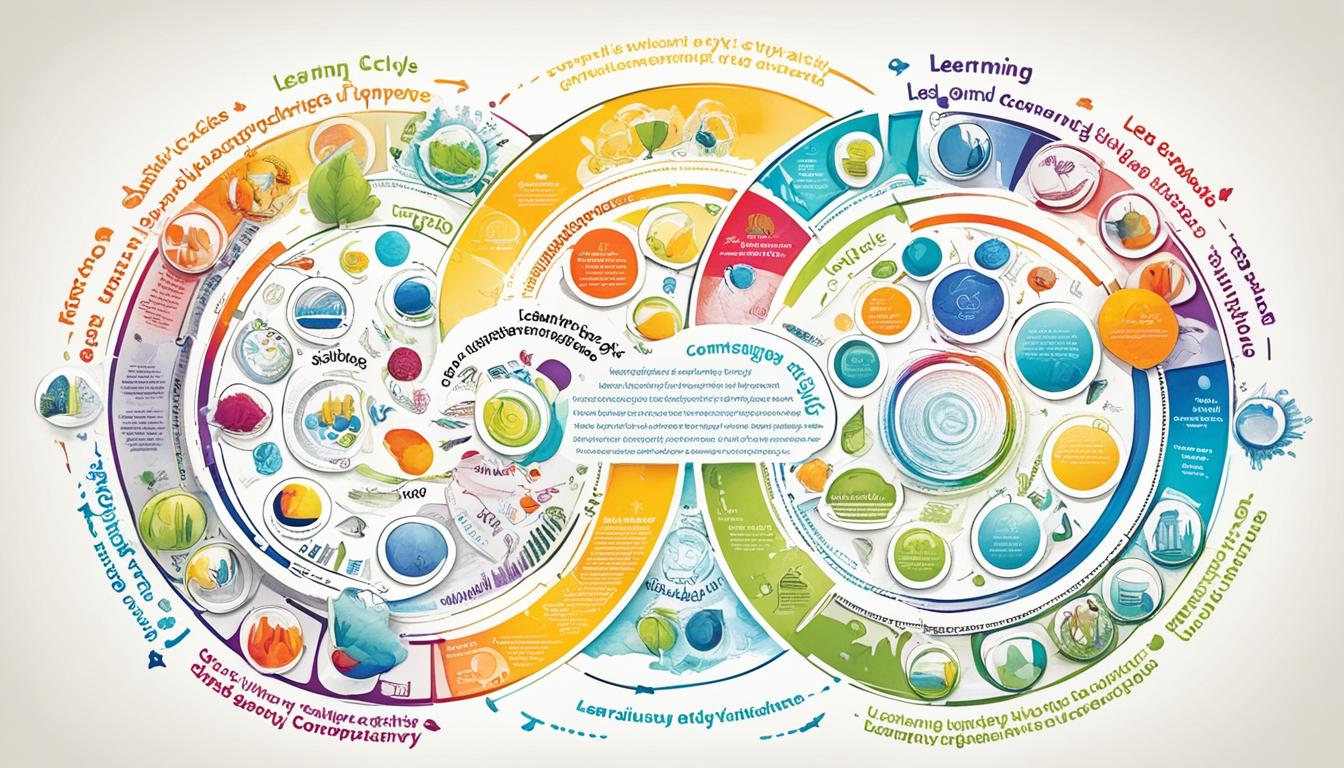Are students with ADHD or learning disabilities left behind in the world of online classes? Many concerns have been raised about how these students may struggle in an online learning environment. However, what if self-paced learning, one of the key features of online classes, actually provides a conducive environment for these students to thrive in their education?
When it comes to students with ADHD or learning disabilities, self-paced learning offers a range of benefits that can address their unique needs. In this article, we will delve into the advantages of online classes for these students and explore how self-paced learning can revolutionize their educational journey.
Key Takeaways:
- Online classes provide a flexible and self-paced learning environment for students with ADHD or learning disabilities.
- Self-paced learning allows students to work at their own pace and revisit lessons as needed.
- Online classes offer content accessibility and assistive technology tools to support students with disabilities.
- Students with disabilities can benefit from the social advantages of online learning, including increased control over interactions.
- Parents, educators, and healthcare professionals play a crucial role in providing support and guidance for students with ADHD or learning disabilities in online classes.
The Accessibility of Online Learning for Students with Disabilities
Students with disabilities, including those with ADHD or learning disabilities, often face physical barriers and challenges in traditional classrooms. However, online learning removes these barriers by providing accessibility and flexibility. Students can learn from the comfort of their own homes, customize their learning experience, and have more control over their schedule and course navigation. This accessibility is especially beneficial for students with disabilities.
Online learning provides a level playing field for students with disabilities. By eliminating physical barriers, such as inaccessible classrooms or lack of specialized equipment, online classes ensure that students can fully engage in their studies. This inclusive approach allows students to focus on their education without the added stress of navigating physical environments that may not be designed to accommodate their needs.
One of the key advantages of online learning for students with disabilities is the ability to learn from the comfort of their own homes. Students can create a personalized and comfortable learning environment that suits their individual needs. This can greatly enhance their concentration and overall learning experience.
Furthermore, online learning allows for a greater degree of flexibility. Students with disabilities can adapt their schedules to accommodate their unique circumstances and learning styles. They can engage with course materials at their preferred pace and revisit lessons as needed. This flexibility promotes individualized learning, fostering greater understanding and retention of the material.
Course navigation is also made easier in the online learning environment. Students can access educational materials and resources with just a few clicks, eliminating the need for physical movement within a classroom setting. This ease of navigation ensures that students can efficiently access the information they need to succeed in their studies.
The accessibility of online learning extends to communication and collaboration as well. Students with disabilities can engage with instructors and peers through various digital tools, such as video conferencing platforms and discussion forums. These platforms provide equal opportunities for participation and interaction, allowing students to connect with their peers and build social relationships.
Online Learning: Breaking Down Barriers
“Online learning has revolutionized education for students with disabilities, providing them with equal access to learning opportunities and breaking down the physical barriers that limit their educational experiences.”
The image below illustrates the accessibility of online learning for students with disabilities:
Benefits of Online Learning for Students with Disabilities
- Flexibility to learn from home
- Customizable learning experience
- Greater control over schedule and course navigation
- Equal access to educational materials
- Opportunities for personalized learning
- Enhanced concentration and focus
- Improved retention of material
- Accessible communication and collaboration tools
Content Accessibility and Assistive Technology in Online Classes
Online classes not only provide convenience and flexibility for students with disabilities but also offer numerous tools and technologies to enhance content accessibility. These features ensure that students have equal access to educational materials, regardless of their disabilities.
One example of this is the availability of online textbooks that are compatible with screen readers. Students with vision disabilities can now access the same learning materials as their peers without the need for Braille textbooks. This removes the barriers that they may face in traditional classrooms and promotes inclusivity in online learning.
Additionally, online classes incorporate various assistive technology tools to support students with different disabilities. Live captioning, for instance, allows students with hearing impairments to follow lectures and discussions effectively. Dictation software enables students with physical disabilities to participate in class discussions and complete assignments. Grammar and spelling tools assist students with learning disabilities in improving their written communication skills.
Online learning also caters to the diverse learning preferences of students with disabilities. It allows for multiple ways of presenting content, such as text, audio, and video formats. This flexibility enables students to engage with the material in a way that best suits their individual needs, enhancing their understanding and retention of the content.
The Importance of Content Accessibility
"Content accessibility is crucial in ensuring that students with disabilities have an equal opportunity to learn and succeed in online classes. By offering various tools and technologies, online learning platforms empower these students to actively participate in their education."
By prioritizing content accessibility and incorporating assistive technology, online classes create an inclusive learning environment where students with disabilities can thrive alongside their peers. It is essential for educators and online learning platforms to continue improving content accessibility to ensure equal educational opportunities for all students.
Social Benefits of Online Learning for Students with Disabilities
Online learning offers a range of social benefits for students with disabilities that may be different from those experienced in traditional classrooms. One significant advantage is that students have more control over their interactions, allowing them to choose what they reveal about themselves to their classmates and peers. This can be especially empowering for students with disabilities, as they have the freedom to shape their online persona and disclose their disability on their own terms.
For students with learning disabilities, online learning can also have a positive impact on their social skills. The self-paced nature of online classes provides these students with the opportunity to improve attention, self-regulation, and engagement. With fewer distractions and a more structured learning environment, students with learning disabilities can focus on their studies, interact with their classmates, and actively participate in discussions.
Another key benefit of online learning for students with disabilities is the ability to contact instructors at any time. This flexibility allows students who may experience periods of incapacity, such as those with chronic health conditions, to reach out for support and clarification whenever they need it. The availability of online communication channels helps bridge the gap between students and teachers, ensuring that no questions or concerns go unanswered.
"Online learning provides an inclusive environment where students with disabilities can participate on their own terms and engage in meaningful interactions with their peers and instructors."
While communication barriers may exist in the online learning environment, such as the absence of non-verbal cues, overall, the social benefits for students with disabilities are notable. Online learning fosters a sense of independence, encourages self-advocacy, and creates opportunities for connections that may not have been possible in traditional classroom settings.
Social Benefits Comparison
| Social Benefits | Online Learning | Traditional Classroom |
|---|---|---|
| Control over interactions | ✓ | × |
| Improved social skills | ✓ | × |
| Accessible instructor communication | ✓ | × |
| Opportunities for self-advocacy | ✓ | × |
As seen in the table above, online learning provides a unique set of social benefits that are not typically found in traditional classrooms. These benefits contribute to a more inclusive and empowering learning experience for students with disabilities.

Planning and Organization in Online Classes for Students with ADHD
Students with ADHD often face challenges when it comes to planning and organization. However, online classes can provide a structured and organized learning environment that supports their unique needs. By implementing effective planning and organization strategies, students with ADHD can thrive academically in online classes.
The Flexibility of Online Learning
One of the key advantages of online classes for students with ADHD is the flexibility it offers. Unlike traditional classrooms with rigid schedules, online learning allows students to work at their own pace and revisit lessons as needed. This flexibility enables students with ADHD to better manage their time and achieve a balance between academic responsibilities and personal well-being.
"Online classes have given my child with ADHD the freedom to learn at their own pace. They can take breaks when needed and dive deeper into subjects they find interesting. It's been a game-changer for our family!" - Parent of a student with ADHD
Creating a Schedule for Success
Parents and educators play a crucial role in helping students with ADHD maintain a structured routine in online classes. By creating a daily schedule, allocating specific times for lessons, breaks, and screen-free activities, students can develop a sense of predictability and consistency. This structure promotes focus, organization, and better time management skills.
Utilizing Visual Tools and Reminders
Visual tools and reminders are effective strategies for students with ADHD to stay organized and on track. Utilizing digital calendars, color-coded task lists, and visual cues can help students prioritize their assignments, manage deadlines, and break down tasks into manageable steps. These visual aids provide clarity and reduce overwhelm, enabling students to stay organized and complete their work efficiently.
Collaborating with Educators and Peers
Effective planning and organization in online classes involve collaboration between students, educators, and peers. Open communication channels, such as email or online platforms, allow students to reach out for clarification or support when needed. Collaborative tools and group discussions provide opportunities for students to learn from their peers and exchange ideas, fostering a sense of community and engagement in the online learning environment.
Supporting Resources for Planning and Organization
Various online resources and tools are available to support planning and organization for students with ADHD. These resources include digital calendars, time management apps, and task management platforms. Additionally, educational websites and online communities offer tips, strategies, and support specifically tailored to students with ADHD, providing valuable resources for effective planning and organization.
Summary
Online classes offer a structured and organized learning environment for students with ADHD, allowing them to work at their own pace and develop effective planning and organization skills. By utilizing the flexibility of online learning, creating schedules, utilizing visual tools, collaborating with educators and peers, and utilizing available resources, students with ADHD can succeed academically and thrive in the online learning environment.
Online Learning Support for Students with ADHD or Learning Disabilities
Online learning support is essential for students with ADHD or learning disabilities to ensure their success in virtual classrooms. As parents and educators, we play a crucial role in guiding and assisting these students through their online classes. By providing the right tools and resources, we can help them navigate the challenges they may face and create a positive learning environment.
When it comes to online learning support for students with ADHD or learning disabilities, collaboration is key. Working together with healthcare professionals and online educators can provide valuable insights and strategies tailored to the specific needs of these students. Whether it's addressing concerns about attention span or finding alternative methods for comprehension, seeking professional support can make a significant difference in their academic journey.
Creating a positive learning environment at home is another vital aspect of online learning support for students with ADHD or learning disabilities. By setting up a designated study area, minimizing distractions, and establishing a routine, we can help them stay focused and engaged during their virtual classes. Additionally, providing encouragement and praise for their efforts can boost their confidence and motivation.
Online Learning Support Resources
Fortunately, there are numerous online learning support resources available to assist students with ADHD or learning disabilities. These resources offer tools, strategies, and assistance to help these students thrive in their virtual classrooms. Some of the available resources include:
- Online Tutoring Platforms: Platforms like Khan Academy and Tutor.com offer personalized support and one-on-one tutoring sessions to address specific learning needs.
- Special Education Websites: Websites such as LD Online and Understood provide comprehensive information, strategies, and resources for students with learning disabilities.
- Parent Support Groups: Online communities and support groups allow parents of students with ADHD or learning disabilities to connect, share experiences, and exchange valuable advice.
These online learning support resources can serve as valuable tools for parents, educators, and students themselves in navigating the challenges of virtual education.
The Impact of Online Learning on Academic Performance for Students with ADHD
Research has consistently shown that online learning has a positive impact on the academic performance of students with ADHD. The self-paced nature of online classes allows these students to work at their own pace, which is especially beneficial for those with ADHD who may require more time to process information and complete tasks. By providing a more flexible learning environment, online learning caters to the unique needs of these students, allowing them to focus on their individual strengths and overcome challenges.
Online learning also offers a more comfortable and less distracting environment compared to traditional classrooms. Students with ADHD can create an environment that suits their specific needs, minimizing external distractions and maximizing concentration. This enables them to stay engaged and focused, leading to improved academic performance.
Moreover, online learning provides various accommodations and support systems specifically designed for students with ADHD. These may include visual aids, interactive learning materials, and assistive technologies that enhance their learning experience. With proper support and resources, students with ADHD can benefit greatly from online learning and achieve academic success.
Benefits of Online Learning for Students with ADHD:
- Flexibility to work at their own pace
- Minimized distractions in a comfortable learning environment
- Access to accommodations and support systems
- Enhanced engagement and focus
- Improved academic performance
Overall, online learning offers a conducive environment for students with ADHD to thrive academically. Through its flexibility, tailored support, and reduced distractions, online learning empowers students with ADHD to reach their full potential and excel in their academic endeavors.
| Online Learning Benefits | Traditional Classroom Challenges |
|---|---|
| Flexibility to work at own pace | Rigid schedule and pacing |
| Minimized distractions | Potential for frequent disruptions |
| Access to accommodations and support | Limited resources and support |
| Enhanced engagement and focus | Overwhelming sensory stimuli |
| Improved academic performance | Challenges in keeping up with the class |

"Online learning has provided my child with ADHD the freedom to learn at their own pace and focus on their individual needs. It has been transformative for their academic performance." - Parent testimonial
The Role of Online Learning in Addressing Challenges During the COVID-19 Pandemic
The COVID-19 pandemic has brought unprecedented challenges for students around the world. As schools closed and face-to-face interactions became limited, the continuity of education became a significant concern. In these uncertain times, online learning emerged as a lifeline for students, offering a safe and accessible alternative to traditional classrooms.
Online learning has played a crucial role in addressing the challenges posed by the pandemic. It has enabled students to continue their education while adhering to lockdowns and social distancing measures. By providing a virtual learning environment, online classes ensure that students can access quality education from the comfort and safety of their own homes.
One of the most significant advantages of online learning during the pandemic is its accessibility. Students who face physical or geographical limitations can still participate fully in their education. Whether it's students with disabilities, students living in rural areas, or those facing transportation barriers, online learning eliminates the challenges that traditional classrooms present.
Furthermore, online learning offers flexibility in scheduling and course navigation. Students can design their learning experience to accommodate their individual needs. They can access course materials, lectures, and assignments at their own pace, allowing them to review concepts, pause when needed, and revisit lessons. This flexibility empowers students to take control of their learning journey and overcome potential obstacles.
Online learning has not only provided a solution to the challenges caused by the COVID-19 pandemic but has also opened doors for educational opportunities that were previously inaccessible. It has transformed the way we learn and has demonstrated its resilience in adapting to unforeseen circumstances.
The benefits of online learning extend beyond academics. It has fostered valuable skills such as self-discipline, time management, and digital literacy. Students become more independent learners, acquiring skills that will serve them beyond their academic journey. Additionally, online platforms encourage collaboration and interaction among students, mirroring the social aspect of traditional classrooms.
Online Learning Challenges During the COVID-19 Pandemic
While online learning has proven to be a valuable tool, it is essential to acknowledge the challenges it presents. The sudden shift from in-person to virtual education has required adjustments from both educators and students. Technical difficulties, limited access to resources, and potential distractions at home are among the challenges that students may encounter.
Table: Online Learning Challenges During the COVID-19 Pandemic
| Challenges | Solutions |
|---|---|
| Technical difficulties | Providing technical support and resources to students |
| Limited access to resources | Ensuring online materials are accessible to all students |
| Potential distractions at home | Creating a conducive learning environment and establishing routines |
These challenges demand collaborative efforts among stakeholders, including educators, parents, and policymakers, to ensure that all students can access online learning effectively. By addressing these challenges, we can maximize the potential of online learning and provide inclusive education for all students.
In conclusion, online learning has played a crucial role in addressing the challenges presented by the COVID-19 pandemic. It has provided a safe and accessible learning environment, enabling students to continue their education despite the disruption caused by the global health crisis. While online learning does present its own set of challenges, they can be overcome with collaborative efforts and the implementation of effective solutions. The resilience and adaptability of online learning have proven its worth in ensuring the continuity of education for students worldwide.
Conclusion
In conclusion, online classes provide numerous benefits for students with ADHD or learning disabilities. The flexibility of online learning enables students to adapt their education to their specific needs and learning styles. With the accessibility of online classes, students can learn from the comfort of their own homes and customize their learning experience. Additionally, the support and resources available in online learning can help students with ADHD or learning disabilities thrive in their education.
By embracing online learning, students with ADHD or learning disabilities have the opportunity to excel academically and overcome the challenges they may face in traditional classrooms. Online classes create an inclusive environment where every student can learn at their own pace and receive the necessary support. This promotes a positive learning experience and enhances their overall academic performance.
Overall, the benefits of online classes for students with ADHD or learning disabilities cannot be overstated. Online learning provides a valuable and inclusive option that empowers these students and allows them to reach their full potential. With the flexibility, accessibility, and support offered by online classes, students can thrive in their education and build the foundation for a successful future.
FAQ
Are online classes beneficial for students with ADHD or learning disabilities?
Yes, online classes offer numerous benefits for students with ADHD or learning disabilities. The flexibility, accessibility, and support provided by online learning can enhance their academic performance and overall learning experience.
How does online learning provide accessibility for students with disabilities?
Online learning removes physical barriers and provides accessibility for students with disabilities. They can learn from the comfort of their own homes, customize their learning experience, and have more control over their schedule and course navigation.
What tools are available to enhance content accessibility in online classes?
Online classes offer various tools and technologies to enhance content accessibility for students with disabilities. These include features like screen readers for vision disabilities, live captioning, dictation software, and grammar and spelling tools for different disabilities.
What social benefits does online learning offer for students with disabilities?
Online learning provides social benefits for students with disabilities. They have more control over their interactions and can choose what they reveal about themselves to their classmates and peers. Online learning can also improve attention, self-regulation, and engagement for students with learning disabilities.
How can online classes provide structure and organization for students with ADHD?
Online classes can provide a structured and organized learning environment for students with ADHD. Parents and educators can create a schedule for the students, designate specific times for lessons, breaks, and screen-free activities. The flexibility of online learning allows students with ADHD to work at their own pace and revisit lessons as needed.
What kind of support is available for students with ADHD or learning disabilities in online learning?
Online learning requires additional support for students with ADHD or learning disabilities. Parents and educators can provide guidance and assistance in navigating online classes. Students can also reach out to healthcare professionals and online educators for support. Online learning support resources are available to provide tools and assistance to these students.
Can online learning have a positive impact on academic performance for students with ADHD?
Yes, research has shown that online learning can have a positive impact on academic performance for students with ADHD. The self-paced nature of online classes allows these students to work at their own pace and focus on their individual needs.
How has online learning addressed challenges during the COVID-19 pandemic?
Online learning has played a crucial role in addressing challenges during the COVID-19 pandemic by providing a safe and accessible learning environment. It has allowed students to continue their education during lockdowns and social distancing measures.
Is online learning a valuable option for students with ADHD or learning disabilities?
Yes, online learning has proven to be a valuable and inclusive option for students with ADHD or learning disabilities. It offers flexibility, accessibility, and support that can help these students thrive in their education.









